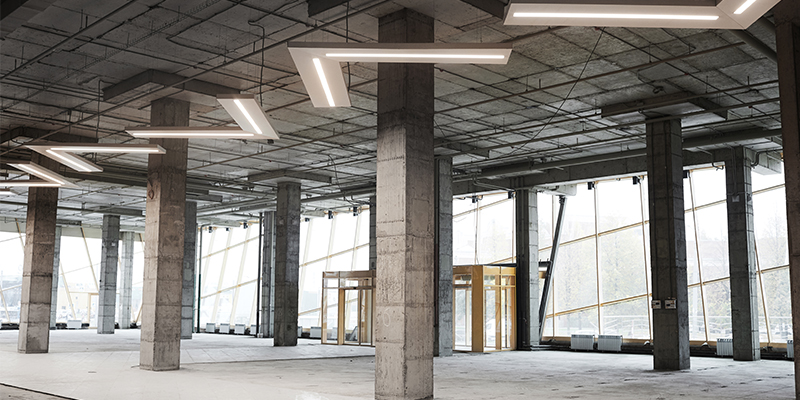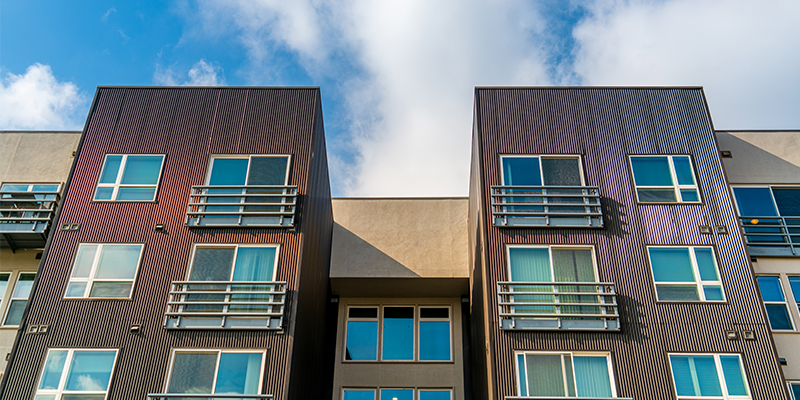Often in large development projects, design and construction teams focus on completing the building for the occupants’ short-term needs – about five years out from completion. Yet modern buildings have the potential to reach a lifespan of 30-50 years before requiring major renovations, according to Getty Conservation Institute. As climate change worsens and building resiliency becomes more top of mind for building owners and investors, a more forward-thinking approach to development is necessary.
Project teams can look through the lens of future facilities management at the inception of the project to make decisions that will reduce maintenance costs, lengthen the building’s lifespan, bolster its resiliency rating, and improve tenant experience. This approach calls for considering longer-term impacts of design decisions on the performance, maintenance and future renovations of a building.
Here are some of those considerations:
Replacement costs and design standards
While a tenant may want a diversity of unique, bespoke finishes throughout the space – such as lighting fixtures, carpet, ceiling tiles, furniture and filters – there are a few challenges such design features pose in the long run. In order to replace these finishes as they depreciate over time, building teams order extra stock to keep on hand for the facilities team to use throughout the building’s lifetime. This attic stock, however, has a limit – there’s only so much square footage you can dedicate to store yet-to-be-used items.
Additionally, the process of managing replacements for finishes can change over time. The ease of procurement may change as supply chain issues arise or materials become scarcer. New requirements may arise around purchase orders or shelf-life management procedures. And unique, trendier finishes may be discontinued; for example, a patterned carpet dye might go out of stock, and a similar pattern would be hard or expensive to replicate.
Overall, the desire for stylish and diverse finishes should be balanced with the ability to preserve the design as well as the related maintenance needs over time.
Life cycle costs
Evaluating building design from a future facilities management perspective also sheds important light on potential life-cycle costs of building systems and equipment. Consider the following:
- Infrastructure value and performance depends on selection. From HVAC and lighting to energy and utilities, the state of a building’s mechanical, electrical and plumbing (MEP) and other facility systems can have significant impacts on long-term costs. For example, energy- or water-efficient solutions may cost more up-front but can generate major monthly savings over time.
Meanwhile, nothing lasts forever – all equipment needs to be repaired and/or replaced at some point. Choosing high-quality, highly rated building equipment can lead to better, longer performance – and ultimately lower costs – as equipment ages. - Clean energy decisions affect the bottom line in more ways than one. Many tenants are also interested in clean energy solutions, which are often made possible with Power Purchase Agreements (PPAs) between a public or private company and the utility company. Covering design, permitting, financing and installation for solar, fuel cell and/or battery storage, these long-term contracts can bridge the gap between up-front capital, and important emissions-reducing energy solutions. But they’re complicated to structure, so big-picture value depends on informed negotiation.
In addition to meeting corporate sustainability goals, more tenants will be looking for clean energy PPAs to meet regulatory needs, too. For example in California, Title 24 states that as of January 1, 2020, all new construction and renovations to residential and commercial buildings must meet net-zero electricity guidelines.
These PPAs also benefit the owners and/or tenants by providing stable utility commodity rates for a long period of time, allowing companies to better manage their complex budgets. - Preventive and ongoing maintenance programs. All building owners and operators will need to establish preventive maintenance programs once the building comes online and is occupied. But depending on how you set up these requirements, they can have a ripple effect on everything from contracts and training needs to organizational agility.
So, consider preventive maintenance with an insider perspective. How can you make selections of equipment and systems that are straightforward to maintain? What are the implications of, say, requiring long-term proprietary service contracts? At a glance, it may yield short-term savings, but in the long run, the inability to negotiate can cost even more. If in-house staff training and/or specialty training and certifications are needed, those costs can add up in a variety of ways, especially if they’re required annually and require staff to travel offsite to get the training. - Specialty finishes require specialty maintenance expertise. Your tenants may crave treated wood or other sensitive flooring. But these may have unique maintenance requirements that call for special equipment and staffing. Developers and owners should bear in mind the potential costs of ongoing preventive maintenance for specialty materials, such as equipment for the annual re-staining of wood, or staff training for unique window washing systems.
Supply chain and trade labor considerations
As we are seeing now, the supply chain can also be unpredictable and volatile – which can make managing facility costs something of a moving target without informed strategy.
The first step is simply to take mass uncertainty into account as you choose products for the various building systems and finishes. Ask your team: Are there good alternatives and options for replacement parts in case the existing versions are not obtainable? Also consider using manufacturers that stand behind their products for a long time, without quickly retiring older versions and phasing out replacement production.
Trade labor shortages are also creating new challenges for owners and developers. With fewer young people entering trade professions as electricians, plumbers, masons and carpenters, the journey-level workforce is becoming limited – which can lead to project delays and/or higher costs, over time. Note, too, that skilled maintenance employees are getting even harder to find, given construction’s relatively higher pay.
Looking ahead: Bring facilities experts to the planning table
In fast-changing times like these, building with flexibility is key. Involve maintenance team members early on in the design process and throughout the project. To ensure your building can stand the test of time – including future renovations – ensure its bones are classic and well-built, but its design can support a variety of needs. All MEP systems should also be equipped with the right technology and set up to adapt to future technology when the time comes.
It’s easy to get stuck in immediate, short-term construction costs concerns and the pricing necessary to install required systems. But the right up-front investments can pay off significantly over the long term, and a sophisticated owner’s rep team can help you bake that potential value into the project from day one – and beyond.








